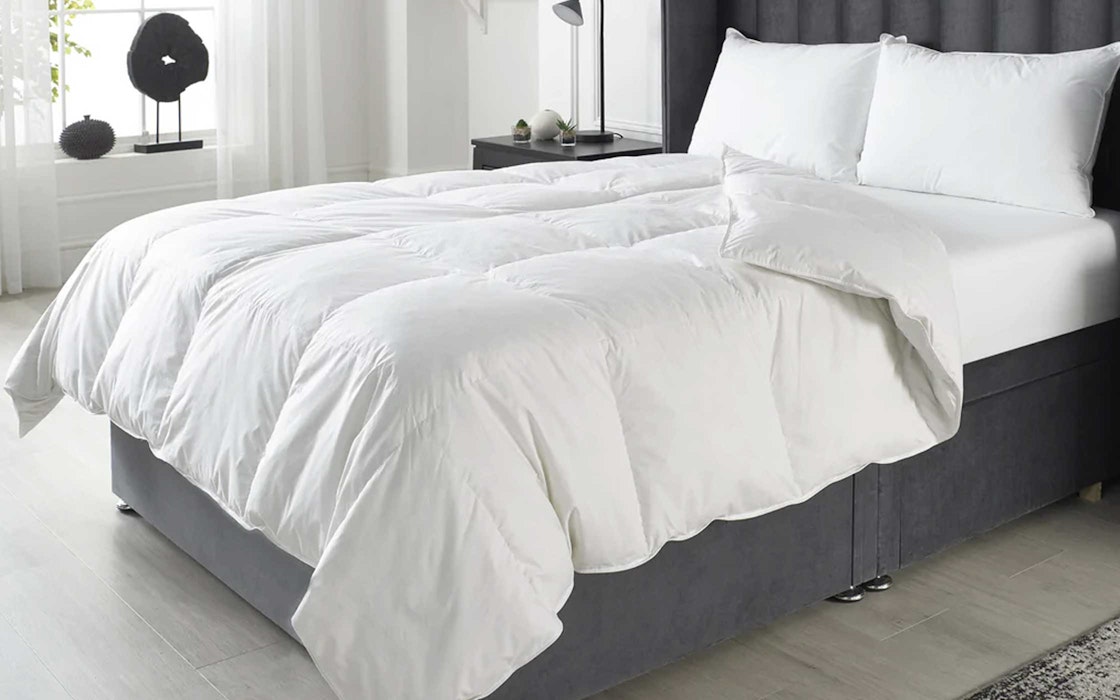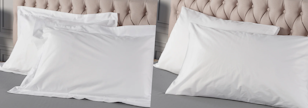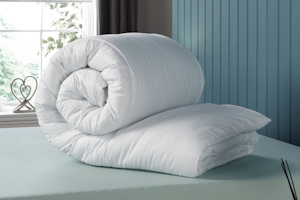30 Jun 2025

How Long Can You Keep a Goose Down Duvet?
29 Dec 2022
Being at the high-end of the bedding scale, goose down duvets are a worthy investment. In comparison with synthetic and feather fillings, goose down is the by far the best choice; goose down duvets create a warm, luxurious sleeping experience, and are also very easy to care for. Even so, all bedding products come with a finite lifespan and there will eventually come a time when your duvet needs replacing.
With the right care, you can potentially keep a goose down duvet for up to 10 years before it will need replacement. Goose down filling is extremely durable and will last many years, and several washes, before it will start to deteriorate. Signs that it’s time to replace your goose down duvet include the wearing down of the filling and/or casing, and the duvet becoming flat and losing its warmth.
How Long Can You Keep a Duvet?
The general advice regarding bedding is to change your duvet every five years or so. However, the lifespan of a duvet will ultimately depend on a few factors; the type of filling it contains, its overall quality, and how you take care of it will all impact how long your bedding lasts.
With cheaper, synthetic materials, you may have to change your duvet sooner than 5 years; oppositely, duvets made with higher-quality natural materials can last much longer than this. Duvets with natural fillings are also much easier to keep clean than synthetic duvets. For these reasons, the material and filling type are two very important considerations to make when choosing a new duvet.
How Long Should a Goose Down Duvet Last?
Goose down duvets offer some of the longest lifespans of any duvet type. A decent goose down duvet should last for at least 5 years, with the highest-quality products lasting as long as 10 years. Again, this lifespan will ultimately depend on how you take care of the duvet; but, assuming you care for it correctly, a goose down duvet will last longer than both synthetic or feather alternatives.
The longer lifespan of a goose down duvet is all thanks to the filling it contains. Goose down is a luxuriously soft and insulating material made from the underplumage of geese. Not only does this filling create an extremely comfortable bedding, it is also the most durable against washing and usage. Synthetic, feather, and even duck down fillings are all inferior when compared against these characterestics of a goose down duvet.

How Often Should You Wash a Goose Down Duvet?
Under normal conditions, you’ll only need to wash a goose down duvet once every one to two years. The only exception to this rule is in the case of an accidental spill or soiling of the duvet; you must address such accidents as soon as they happen to preserve the duvet’s condition. Otherwise, yearly washing will suffice to keep your goose down duvet clean and fluffy.
In addition to having minimal washing requirements, the actual process of washing a goose down duvet is very straightforward. No professional cleaning is necessary as you can wash a goose down duvet in your washing machine at home. Duvets made from cheaper synthetic materials don’t always fare well with at-home machine washing; it’s common for the synthetic filling to come out of the wash misshapen and clumpy. Goose down duvets, on the other hand, hold up well to machine washing due to the filling’s natural durability.
How to Prolong the Lifespan of Your Goose Down Duvet
Like we’ve said, a goose down duvet can last up to a decade before needing replacement. Improper care will shorten this lifespan, but fortunately, goose down duvets are very easy to maintain. You can follow the simple tips we’ve explained below to prolong the lifespan of your duvet.
1. Use a High-Quality Duvet Cover
A duvet cover acts as a first line of defence against contaminants and other agents of degradation to the duvet. The duvet cover absorbs substances like skin cells, oils, and dust, keeping the encased duvet clean. As it forms the outermost layer of the duvet, the material of the duvet cover is particularly important; we recommend opting for a breathable fabric like cotton to reduce sweating during sleep.
2. Ensure Duvet is Correctly Oriented in Cover
When you insert your duvet into its cover, ensure that the duvet is oriented correctly. All four corners of the duvet should be snugly fitted into the four corners of the duvet cover. If the duvet is in the cover at a bad angle, it will bunch up in some places, leaving others unfilled. Being mindful of how your duvet is oriented in its cover will prevent clumping while keeping your bedding comfy.
3. Avoid Overwashing the Duvet
Although home washing is easy and safe, it’s possible to still overwash a goose down duvet. As we’ve explained, it’s typically only necessary to wash a goose down duvet every one to two years. Washing more often than this is generally unnecessary and will only cause the premature deterioration of your duvet. To reiterate, the only exception to this rule is in the case of an accidental spill; you should wash the duvet immediately if this situation arises. You also have the option of airing out your duvet in between washes to give it a refresh.
4. Avoid Lying on Top of the Duvet
Avoid lying on top of the duvet whenever possible. While it may be tempting, lying on a goose down duvet is one of the worst thing you could do for its condition; the pressure from your bodyweight can crush the down clusters in the duvet’s filling, causing it to degrade more quickly. For the same reason, try to avoid twisting or scrunching the duvet when you’re in bed.
5. Rotate Duvet Regularly
Make a point of rotating your duvet every few months of use. This is to distribute the wear on the duvet evenly, rather than one end prematurely wearing out from overuse.
Signs that You Need to Replace Your Goose Down Duvet
There are a few telltale signs that indicate when it’s time to replace your goose down duvet; these include when the filling is worn down, the casing material has splits or holes, or the duvet is flat, losing warmth, or isn’t responding well to washing. Noticing one or more of these issues is an indication that the duvet has reached the end of its lifespan.
The Filling is Worn Down
When it comes to the end of its lifespan, the filling in a goose down duvet will start to deteriorate. You may notice that portions of the filling start to wear down; the wear may be particularly noticeable at the edges of the duvet where the most friction occurs during use.
The Duvet is Flat and Deflated
Goose down duvets are usually light and fluffy, with these duvets providing the most luxurious and comfortable bedding experience. However, your duvet may become flat and deflated at the end of its lifespan. Even with manual plumping, you may not be able to fluff up the duvet. This is a sign that the down filling has collapsed and has consequently lost its springy texture.
The Material of the Duvet is Falling Apart
With any kind of duvet, the deterioration of the casing material is also inevitable. You may find stray feathers escaping from your duvet due to a split seam or hole in the casing. Spotting any kind of split or hole is another clear sign that the duvet has reached the end of its lifespan.
The Duvet Doesn’t Feel as Warm
Goose down duvets are excellent at holding onto warmth and creating a cosy bed. When the filling starts to wear out, the duvet will lose its natural insulating properties. You may notice that the duvet doesn’t keep you as warm as it should at night; this is a definite sign that you should replace your duvet with a new one.
The Duvet Doesn’t Respond Well to Washing
As we’ve discussed, goose down duvets are easy to wash at home. The down filling is typically very durable and responds well to machine washing. So, if your duvet starts to come out of the wash worse for wear, it’s time to replace it.


